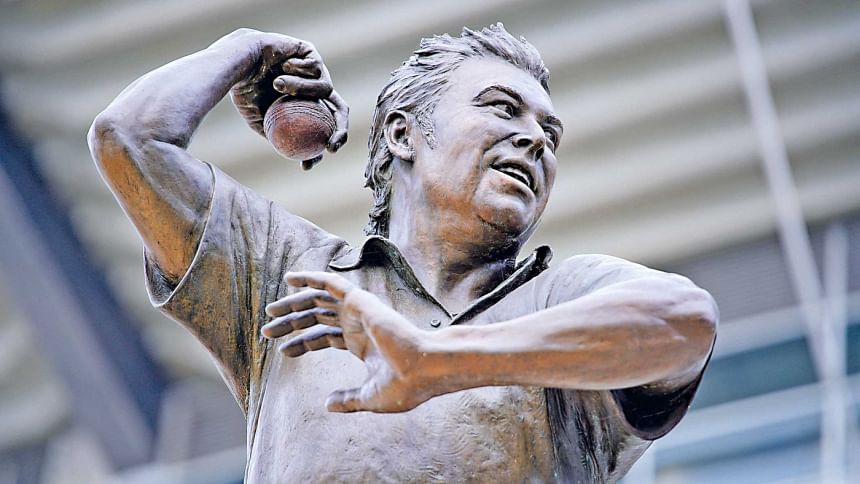Shane Warne: A legend. A maverick. A champion.

In an attempt to put these words together, I went through every living memory of Shane Warne. The difficult part is obviously to put my thoughts into words; Warne entered my senses when cricket started to excite me at the age of ten. A whole lifetime of religiously following his playing career, post-international IPL career and then the commentary and punditry. The cricket fan in me takes centrestage when Warne was in front of me. Childhood ended for me when Bangabandhu National Stadium stopped hosting cricket. Warne's death marks the end of an era of cricket following for the absolute love for the game.
Warne pricked the senses of a ten-year old me in the 1990s with his theatre. Staring down the batsman like a fast bowler, the ball flicking from one hand to the other, the walk, the action, the flick of the wrist. Turn, spin, overspin. He had it all.
Many know Warne after "the ball of the century" in 1993. The big spinning leg-breaks on bouncy tracks in Australia were unheard of before Warne regularly produced such deliveries. Then came the flipper, the zooter and the slider. Truth be told, not many batsmen knew what was happening when Warne was in his elements.
Warne was in the thick of things in six Ashes triumphs from 1993 to 2007, losing only once in the epic 2005 series in England. He was part of the Australia side that wrested back the Frank Worrell Trophy in 1995. He won the World Cup in 1999, and one of his final big achievements was playing a vital role in Australia's 2004-05 Test series win in India.
He finished on 708 Test wickets at 25.41 average, bettered only by Muttiah Muralidharan who overtook him in numbers. The pair were immortalized when they were named in the Australia-Sri Lanka Test series trophy some years ago.
Warne was a handy batsman lower down the order, most famous for bailing out Australia in a 2001 Test against New Zealand with his 99, his highest score. He made quick runs as an ODI pinch-hitter a few times.
But it was his fielding that often surprised many. Warne was simply world-class at the slips for many years. When Mark Taylor retired, he took up the first slip position. Around the outfield too, he was athletic and powerful. Little details that often got lost in his overarching Hollywood persona.
Warne was embroiled in a match-fixing scandal, got banned for a year for using a banned substance. He had his personal life pasted in the tabloids in the UK quite regularly. Warne even got caught pinching a cigarette when he was promoting a nicotine-substitute manufacturer. But it all faded away in front of his mastery.
Warne was keenly aware of what he meant to the game. He was an out-and-out cricketer, and a revolutionary leg-spinner. Before him, the likes of Abdul Qadir and Richie Benaud had been successful leggies. Qadir, like Warne, was also a maverick, famously growing a goatee so that he looked like a French magician. Imran Khan thought it would add to his mystique. Benaud was the straight cut guy. He was the famous Australian captain from the 1960s who was more of an allrounder.
Warne's story touched everyone. He had the talent to play Australian rules football for his beloved St Kilda Club in Melbourne, but he went into cricket. The initiation wasn't great: he ran away from the Australia Cricket Academy. Thought it was too much hard work.
His Test debut was another relatable experience. He got smashed by Ravi Shastri, Sachin Tendulkar and co, famously taking just one wicket in the game.
Terry Jenner, Warne's leg-spin guru, dragged him out of his house literally, and retrained him as a bowler. Warne's rebirth as a leg-spinner was also the rejuvenation of cricket's most difficult art.
Warne being pitted against Sachin Tendulkar in the late 1990s gave cricket fans of that generation its first big rivalry. Ahead of the 1998 tour, Tendulkar famously trained harder for Warne, who was quietly struggling with a shoulder injury. Tendulkar had the wood over Warne for most of his career, but the nature of the rivalry stood out. It didn't have the brutality of the Don Bradman-Harold Larwood battles, or the combustibility of the Dennis Lillee-Viv Richards skirmishes. When Warne bowled to Tendulkar or Lara, it was cricket at its best. A mesmerizing artist confronting two masters with the willow.
Warne never left cricket even after his celebrated retirement in 2007. He was always going to be a hot property in T20s. He led Rajasthan Royals to the inaugural IPL triumph, famously promoting the likes of Ravinder Jadeja and Yusuf Pathan into starring roles. Warne was always known as a natural leader and in the few occasions he led Australia, he gave glimpses of his aggressive captaincy. Rajasthan gave him the blank canvas to draw up what he wanted to do.
Perhaps Warne's greatest legacy is the unbelievable number of leg-spinners who now rule the roost in T20s. Rashid Khan, Imran Tahir, Adil Rashid, Adam Zampa and Yuzevendra Chahal are just some of the names that come up in everyday conversations. The progress of the left-arm unorthodox spinners Kuldeep Yadav and Tabraiz Shamsi is Warne's contribution to cricket; now cricket coaches, analysts, orgainsers and team owners trust leg-spin.
As I search for the final words, thousands swim around but only three probably describe Warne the best.
A legend. A maverick. A champion.
**The writer is Bangladesh Correspondent for ESPNcricinfo.

 For all latest news, follow The Daily Star's Google News channel.
For all latest news, follow The Daily Star's Google News channel. 



Comments